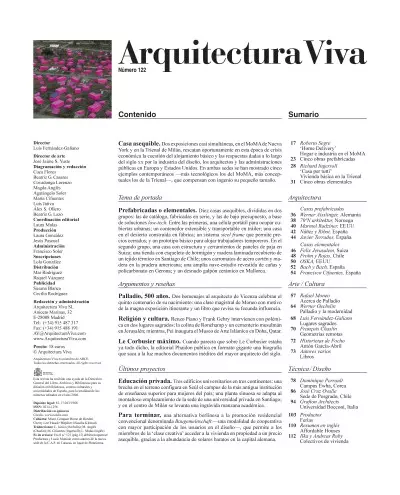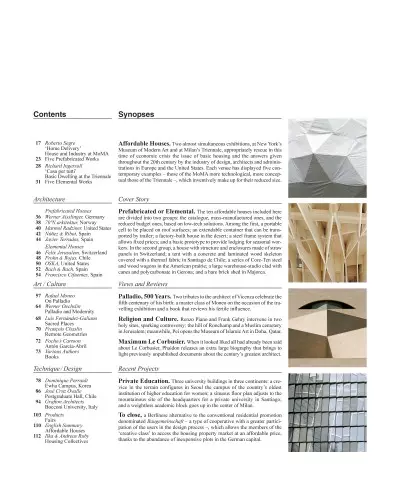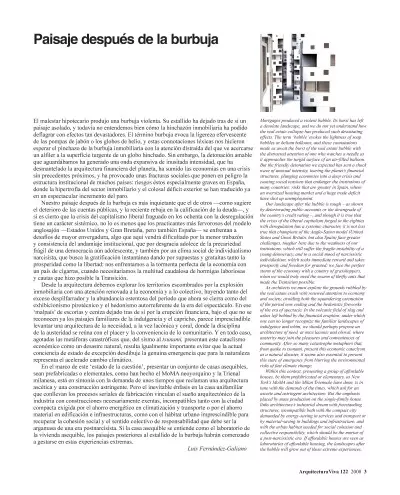Synopses
Affordable Houses. Two almost simultaneous exhibitions, at New York’s Museum of Modern Art and at Milan’s Triennale, appropriately rescue in this time of economic crisis the issue of basic housing and the answers given throughout the 20th century by the industry of design, architects and administrations in Europe and the United States. Each venue has displayed five contemporary examples – those of the MoMA more technological, more conceptual those of the Triennale –, which inventively make up for their reduced size.
Contents
Roberto Segre
‘Home Delivery’
House and Industry at MoMA
Five Prefabricated Works
Richard Ingersoll
‘Casa per tutti’
Basic Dwelling at the Triennale
Five Elemental Works
Prefabricated or Elemental. The ten affordable houses included here are divided into two groups: the catalogue, mass-manufactured ones, and the reduced budget ones, based on low-tech solutions. Among the first, a portable cell to be placed on roof surfaces; an extendable container that can be transported by trailer; a factory-built house in the desert; a steel frame system that allows fixed prices; and a basic prototype to provide lodging for seasonal workers. In the second group, a house with structure and enclosures made of straw panels in Switzerland; a tent with a concrete and laminated wood skeleton covered with a thermal fabric in Santiago de Chile; a series of Core-Ten steel and wood wagons in the American prairie; a large warehouse-studio clad with canes and polycarbonate in Gerona; and a bare brick shed in Majorca.
Prefabricated Houses
Werner Aisslinger, Germany
70ºN arkitektur, Norway
Marmol Radziner, United States
Núñez & Ribot, Spain
Javier Terrados, Spain
Elemental Houses
Felix Jerusalem, Switzerland
Frohn & Rojas, Chile
OSKA, United States
Bach & Bach, Spain
Francisco Cifuentes, Spain
Views and Reviews
Palladio, 500 Years. Two tributes to the architect of Vicenza celebrate the fifth centenary of his birth: a master class of Moneo on the occasion of the travelling exhibition and a book that reviews his fertile influence.
Art / Culture
Rafael Moneo
On Palladio
Werner Oechslin
Palladio and Modernity
Religion and Culture. Renzo Piano and Frank Gehry intervene in two holy sites, sparking controversy: the hill of Ronchamp and a Muslim cemetery in Jerusalem; meanwhile, Pei opens the Museum of Islamic Art in Doha, Qatar.
Luis Fernández-Galiano
Sacred Places
François Chaslin
Remote Geometries
Maximum Le Corbusier. When it looked liked all had already been said about Le Corbusier, Phaidon releases an extra large biography that brings to light previously unpublished documents about the century’s greatest architect.
Focho’s Cartoon
Antón García-Abril
Various Authors
BooksRecent Projects
Private Education. Three university buildings in three continents: a crevice in the terrain configures in Seoul the campus of the country’s oldest
institution of higher education for women; a sinuous floor plan adjusts to the mountainous site of the headquarters for a private university in Santiago; and a weightless academic block goes up in the center of Milan.
Technique / Style
Dominique Perrault
Ewha Campus, Korea
José Cruz Ovalle
Postgraduate Hall, Chile
Grafton Architects
Bocconi University, Italy
To close, a Berlinese alternative to the conventional residential promotion denominated Baugemeinschaft – a type of cooperative with a greater participation of the users in the design process –, which allows the members of the ‘creative class’ to access the housing property market at an affordable price, thanks to the abundance of inexpensive plots in the German capital.
Products
Fairs
English Summary
Affordable Houses
Ilka & Andreas Ruby
Housing Collectives
Luis Fernández-Galiano
Landscape after the bubble
Mortgages produced a violent bubble. Its burst has left a desolate landscape, and we do not yet understand how the real estate collapse has produced such devastating effects. The term ‘bubble’ evokes the lightness of soap bubbles or helium balloons, and these connotations made us await the burst of the real estate bubble with the distracted attention of one who watches a needle as it approaches the turgid surface of an air-filled balloon. But the friendly detonation we expected has sent a shock wave of unusual intensity, tearing the planet’s financial structures, plunging economies into a deep crisis and causing social tensions that endanger the institutions of many countries: risks that are greater in Spain, where an oversized housing market and a huge trade deficit have shot up unemployment.
Our landscape after the bubble is rough – as shown by deteriorating public accounts or the downgrade of the country’s credit rating –, and though it is true that the crisis of the liberal capitalism forged in the eighties with deregulation has a systemic character, it is not less true that champions of the Anglo-Saxon model (United States and Great Britain, but also Spain) face greater challenges, tougher here due to the weakness of our institutions, which still suffer the fragile instability of a young democracy, and to a social mood of narcissistic individualism, which seeks immediate reward and takes prosperity and freedom for granted: we face the perfect storm of the economy with a country of grasshoppers, when we would truly need the swarm of thrifty ants that made the Transition possible.
As architects we must explore the grounds rubbled by the real estate crash with renewed attention to economy and society, avoiding both the squandering ostentation of the period now ending and the hedonistic fireworks of the era of spectacle. In the volcanic field of slag and ashes left behind by the financial eruption, under which one can no longer recognize the familiar landscapes of indulgence and whim, we should perhaps propose an architecture of need, at once laconic and choral, where austerity may join the pleasures and conveniences of community. After so many catastrophe metaphors that, from quake to tsunami, present this economic cataclysm as a natural disaster, it seems also essential to prevent this state of emergency from blurring the environmental risks of fast climate change.
Within this context, presenting a group of affordable houses, be them prefabricated or elementary, as New York’s MoMA and the Milan Triennale have done, is in tune with the demands of the times, which ask for an ascetic and astringent architecture. But the emphasis placed by mass production on the single-family house links architecture’s industrial dream with freestanding structures, incompatible both with the compact city demanded by energy-saving in services and transport or by material-saving in buildings and infrastructure, and with the urban habitat needed for social cohesion and collective responsibility, which should be the mortar of a post-narcissistic era. If affordable houses are seen as laboratories of affordable housing, the landscapes after the bubble will grow out of these extreme experiences.








